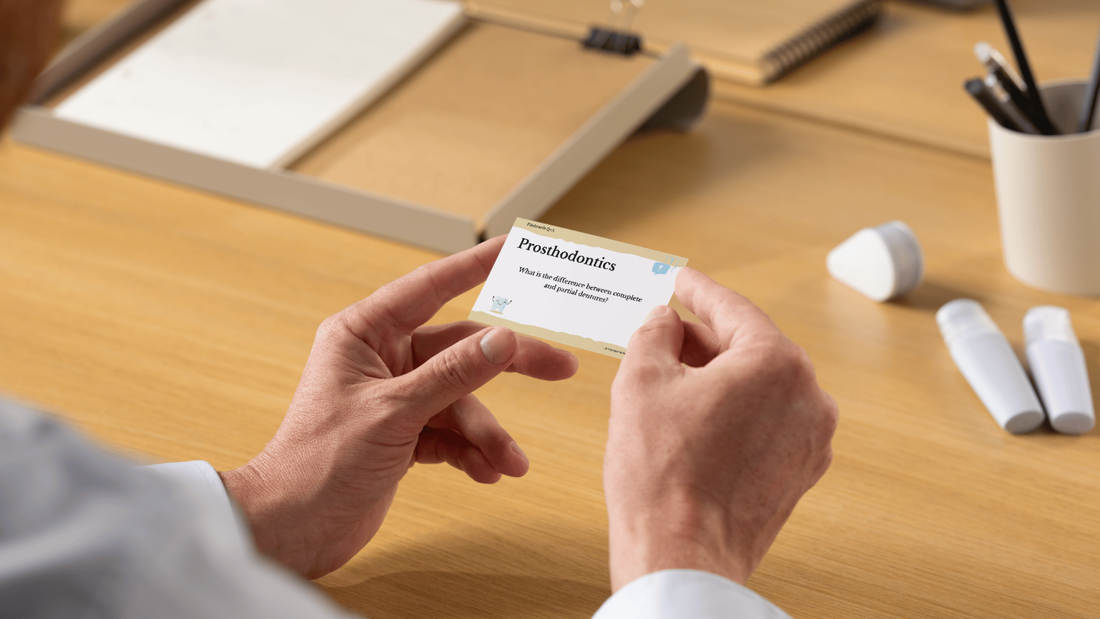
🧠 7 Proven Memory Techniques Every Dental Student Should Know
Share
📌 Table of Contents
- Why Dental Students Struggle to Memorize Effectively
- How Memory Works (and What Science Says)
- Technique #1: Spaced Repetition
- Technique #2: Active Recall with Flashcards
- Technique #3: The Memory Palace
- Technique #4: The Feynman Technique
- Technique #5: Visual Chunking
- Technique #6: Interleaving Study
- Technique #7: Mnemonics for Dental Terminology
- How The Dental Brain Applies These Techniques
- Free Flashcard Pack Download
- Final Thoughts: Study Less, Remember More
🧠 1. Why Dental Students Struggle to Memorize Effectively
Let’s be honest: studying odontology is a memory marathon.
You’re expected to remember:
- Nerve pathways
- Biochemical reactions
- Clinical protocols
- Latin terminology (yep, still relevant)
The problem?
Most students use outdated study methods like passive re-reading or highlighting.
“I review the same material five times and still forget it during the test.”
It’s not your fault. You just need better tools—and better techniques.
🧬 2. How Memory Works (and What Science Says)
Memory isn’t about repeating things a hundred times.
It’s about:
- Encoding information the right way
- Retrieving it often
- Spacing your reviews correctly
Neuroscience shows that students retain more when they:
- Actively test themselves
- Visualize information
- Connect new data to existing knowledge
Let’s turn this into practical strategies.
📚 3. Technique #1: Spaced Repetition
Instead of reviewing material once before the exam, spaced repetition spreads out reviews over time.
How it works:
- Review Day 1 → again on Day 3 → then Day 7 → then Day 14
- Each review refreshes your memory before it fades
💡 Tools like Anki or the Dental Brain Flashcards are designed for this.
SEO keyword: spaced repetition dentistry
🔄 4. Technique #2: Active Recall with Flashcards
This is a game-changer. Instead of re-reading, you test yourself.
Example:
❌ Reading: “What’s the function of the trigeminal nerve?”
✅ Active Recall: Close your book and answer it out loud.
Flashcards:
The best format for this. You can:
- Use apps like Quizlet or physical cards
- Mix bilingual (Italian-English) terms
- Track your weak spots
🧠 Dental Brain Flashcards are structured with high-yield INBDE and university questions.
🏛️ 5. Technique #3: The Memory Palace
Used by memory champions—and now, dental students.
How it works:
- Imagine a familiar place (your home)
- Assign topics to rooms or objects
- Visualize walking through and “seeing” each piece of information
Example:
- Kitchen = dental anatomy
- Sink = types of dentin
- Refrigerator = salivary glands
It’s weird—but it sticks.
👨🏫 6. Technique #4: The Feynman Technique
Teach it to learn it.
Steps:
- Pick a topic (e.g. periodontal disease)
- Explain it out loud in simple terms
- Identify gaps
- Re-explain it until it’s crystal clear
Pro tip: Record yourself and play it back. You’ll instantly hear where you struggle.
🎨 7. Technique #5: Visual Chunking
Break down complex info into visual blocks.
- Use diagrams, flowcharts, color-coded maps
- Group related ideas
- Turn dense lists into visual groupings
Tools:
- Use apps like Notion or GoodNotes
- Dental Brain’s bundle includes pre-made visual study aids ready to print
🔀 8. Technique #6: Interleaving Study
Don’t study the same topic for 3 hours straight.
Instead:
Mix topics:
- 20 min: pharmacology
- 20 min: anatomy
- 20 min: clinical cases
This forces your brain to adapt and retrieve info more effectively.
🧠 It feels harder—but leads to stronger memory formation.
✍️ 9. Technique #7: Mnemonics for Dental Terminology
Mnemonics = memory tricks using rhymes, acronyms, or stories.
Examples:
- “OHIO” = Odontoblasts, Hertwig, Inner enamel, Outer enamel
- “Some Say Money Matters But My Brother Says Big Brains Matter More” – to remember cranial nerve functions
The funnier or weirder, the better it sticks.
🎯 Bonus: Dental Brain includes over 150 high-yield mnemonics in its flashcard set.
📦 10. How The Dental Brain Applies These Techniques
The Dental Brain isn’t just a study tool—it’s a smart memory system.
What’s inside:
📋 Over 1000 bilingual flashcards (spaced repetition ready)
🧩 Integrated mnemonics for difficult topics
📅 Visual planner to schedule active recall sessions
🧠 Smart quiz banks for real-time testing
It’s designed to do the science part for you, so you just follow the plan.
Students say they study faster and remember longer with Dental Brain.
🎁 11. Free Flashcard Pack Download
Try it yourself.
We’ve prepared a free flashcard sample pack with:
- INBDE-style clinical questions
- Anatomy recall prompts
- Bilingual terms
- Built-in mnemonics
No sign-up. Just test your memory the smart way.
💬 12. Final Thoughts: Study Less, Remember More
You don’t need a photographic memory.
You just need the right techniques and the right tools.
💡 Imagine walking into your next exam:
- Calm
- Confident
- Actually remembering what you studied
That’s what happens when you study smart.
🧠 The Dental Brain was built for future dentists like you.
So if you’re tired of forgetting, try something that actually works.
